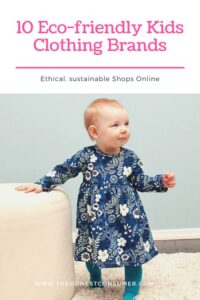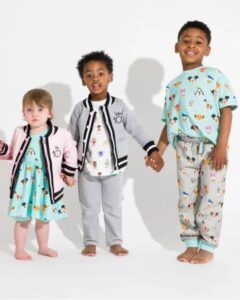Uncategorized
Tips for Finding Ethical and Fair-Trade Kids’ Clothing Brands
As a parent, choosing clothing for your child goes beyond style and comfort—it’s also an opportunity to make socially and environmentally responsible choices. Ethical and fair-trade kids’ clothing brands prioritize workers’ rights, sustainable materials, and transparent practices, ensuring that the clothes your child wears have a positive impact on the world.
Here’s a guide to finding and supporting ethical and fair-trade kids’ clothing brands, along with tips to make responsible choices.
1. Understand What Ethical and Fair-Trade Means
Before diving into the search, familiarize yourself with the principles of ethical and fair-trade fashion.
- Fair-Trade Practices: Ensure workers are paid fairly and work in safe, healthy environments.
- Sustainable Materials: Look for organic cotton, recycled fabrics, or eco-friendly alternatives that reduce environmental impact.
- Transparency: Ethical brands are open about their supply chain and manufacturing practices.
- Minimizing Waste: Brands that prioritize reducing overproduction, reusing materials, or recycling are more sustainable.
Knowing what to look for helps you identify genuine ethical brands.
2. Look for Certifications

Certifications are a reliable way to confirm that a brand adheres to ethical and fair-trade standards.
- Fair Trade Certified: Indicates that workers are paid fairly and operate in safe conditions.
- Global Organic Textile Standard (GOTS): Ensures that clothing is made from organic materials and produced sustainably.
- OEKO-TEX® Standard 100: Certifies that the clothes are free from harmful chemicals.
- B Corporation: Brands certified as B Corps meet high social and environmental standards.
Check a brand’s website or clothing tags for these certifications to ensure they align with ethical principles.
3. Research the Brand’s Mission and Values
Explore the company’s website to learn about their mission, values, and production practices.
- Ethical Statements: Look for clear policies on fair wages, working conditions, and sustainability.
- Supply Chain Transparency: Ethical brands often share details about their factories, sourcing, and partners.
- Impact Reports: Some brands publish annual reports on their environmental and social impact.
Brands that openly share this information are more likely to follow ethical practices.
4. Prioritize Small and Local Brands
Supporting smaller, local businesses often means backing brands that are more focused on ethical production.
- Community-Oriented: Small businesses frequently prioritize fair wages and sustainable practices to support their local communities.
- Unique Designs: These brands often create distinctive, handmade, or small-batch items.
- Lower Carbon Footprint: Local production reduces transportation emissions, contributing to a smaller environmental impact.
Look for artisan brands or local designers in your area to support ethical and sustainable practices.
5. Choose Sustainable Materials
Ethical brands often prioritize eco-friendly materials that are safe for both children and the planet.
- Organic Cotton: Grown without harmful pesticides, it’s gentle on sensitive skin and better for the environment.
- Bamboo Fabrics: Known for being soft, breathable, and sustainable, bamboo is an excellent choice for kids’ clothing.
- Recycled Fabrics: Materials like recycled polyester or repurposed cotton help reduce waste.
- Hemp: Durable, biodegradable, and naturally resistant to pests, hemp is another eco-friendly option.
Always check fabric tags or product descriptions for sustainable material details.
6. Shop Secondhand or Vintage
Secondhand shopping is a budget-friendly and sustainable alternative to buying new.
- Thrift Stores: Explore thrift shops for gently used kids’ clothing from ethical brands.
- Online Marketplaces: Platforms like ThredUp, Poshmark, or local Facebook groups often sell pre-loved ethical kids’ clothing.
- Clothing Swaps: Organize a swap with friends or within your community to exchange kids’ clothes.
By giving clothes a second life, you reduce waste and support the circular fashion economy.
7. Use Online Tools and Resources
Many platforms and organizations provide curated lists or directories of ethical and fair-trade brands.
- Good On You: An app and website that rates brands on their environmental, social, and animal welfare impact.
- Ethical Consumer: Offers detailed reports on ethical brands and their practices.
- Fair Trade Certified Website: Features a directory of fair-trade certified products and brands.
These tools make it easier to find trustworthy ethical kids’ clothing options.
8. Watch for Greenwashing
Be cautious of brands that market themselves as ethical but fail to provide real evidence.
- Vague Claims: Terms like “eco-friendly” or “sustainable” without specific details can be misleading.
- Lack of Transparency: If a brand doesn’t provide information about their production process, it’s a red flag.
- Check Reviews: Look for customer reviews or third-party assessments to verify a brand’s claims.
Sticking to certified brands or thoroughly researching a company can help avoid greenwashing.
9. Invest in High-Quality, Long-Lasting Clothing

Ethical clothing may cost more upfront, but its durability often provides better value over time.
- Better Construction: High-quality stitching and fabrics mean the clothes last longer.
- Hand-Me-Down Potential: Well-made items can be passed down to younger siblings or friends.
- Cost Per Wear: Calculate the long-term savings by comparing the initial cost to the number of wears.
Investing in quality ensures fewer replacements and less waste.
10. Involve Your Kids in the Process
Teaching kids about ethical fashion encourages mindful consumption from an early age.
- Explain the Impact: Talk to them about the importance of fair wages and protecting the environment.
- Let Them Choose: Allow your child to select clothes from ethical brands to make the experience enjoyable.
- Share Stories: Share the journey of their clothes, from how they were made to who made them.
By involving kids, you instill values of empathy and responsibility.
11. Support Brands That Give Back
Many ethical brands contribute to social or environmental causes, amplifying their positive impact.
- Charitable Contributions: Some brands donate a portion of profits to education, healthcare, or environmental conservation.
- Community Development: Look for brands that empower local artisans or invest in their communities.
- Buy One, Give One: Some companies provide clothing to children in need for every item purchased.
Choosing brands that give back aligns your purchases with meaningful causes.
12. Check Return and Repair Policies
Ethical brands often encourage repairing and recycling over discarding clothing.
- Repair Services: Some brands offer free or affordable repair services for their products.
- Take-Back Programs: Brands like Patagonia accept old items for recycling or resale.
- Warranty Options: Durable clothing may come with warranties, ensuring it withstands wear and tear.
These policies promote sustainability and help reduce overall waste.
Conclusion
Finding ethical and fair-trade kids’ clothing brands requires a bit of research, but the rewards are worth it. By choosing brands that prioritize sustainability, worker rights, and transparency, you contribute to a better future for both your child and the planet. From checking certifications to exploring secondhand options, there are plenty of ways to make ethical fashion a part of your family’s lifestyle.
At Regal XX Hue, we’re committed to curating a selection of kids’ clothing that aligns with ethical and sustainable practices. Explore our collection today and take a step toward conscious consumerism!


